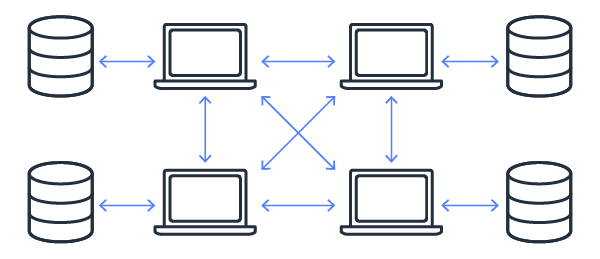Depending on the use case you plan to lift-and-shift into the Cloud, and which provider you chose for it, each of them comes with their own set of chances as well as challenges. However, whenever it comes to Cloud computing we most probably find ourselves either here Amazon AWS or around there Microsoft Azure. As comparisons between these two providers show there is much to discuss about them. Yet, what are the features they provide in the context of Blockchain-based Cloud computing?
AWS Blockchain Solutions
AWS, which is short for Amazon Web Services, is an on-demand cloud computing platform provided by Amazon. Related to Blockchains they provide two different services:
QLDB
The QLDB, unlike a Blockchain implementation like Bitcoin, is focused on the immutability and verification as well as the scalability aspect of the utilized distributed ledger technology and has a central, trusted authority that owns and manages the ledger.
The only question is – Isn’t the main advantage of a Blockchain its decentralized nature? Well, it is mostly in its well-known crypto implementations, yet there is the so-called Blockchain-Trilemma, which, in short, says that the three properties of a Blockchain scalability, security and decentralization exclude each other, so an implementation cannot have all of these properties at once. Even when looking at different crypto currencies it becomes apparent that the respective developers focused on different aspects when it came to their implementation.
Amazon Manged Blockchain
Amazons Manged Blockchain on the other hand is more than a transaction log, like the QLDB, it is a distributed ledger with decentralized ownership. It is compatible with the Hyperledger Fabric framework and Ethereum, yet the network created with this service can also remain private. The service takes care of the hardware for each node, network connections as well as the client software running on each machine. Multiple AWS accounts can be part of one network this way.
Marketplace Options
Beside these two fully flesh out Blockchain services the AWS marketplace also provides software solutions, again, by the Hyperledger Fabric Framework such as Sawtooth, Cello and many more. Just like downloading for instance the their GitHub Repository and compiling and running the code on your local machine everything is simply deployed in the cloud with just a few clicks.
Plug’n’Play
Taking everything a step further now, these solutions may also be combined with one another and thus are not exclusive. For example, one could run a Hyperledger Explorer on Amazon Managed Blockchain according to an architecture like this:
Conclusion
Now we know what to expect when looking at AWS for our next Blockchain application in the cloud. For a deeper insight into the detailed differences between Ethereum and Hyperledger Fabric based Blockchains or so-called Blockchain Templates on AWS feel free to consult the official Developer Guide by Amazon.
Looking for a Deep Dive into the topic?
Also, feel free and go ahead: Deep Dive on Amazon Managed Blockchain
In the next post we are going to look at the Microsoft Azure approach in this domain!
Photo by Aleksandar Pasaric on Pexels 🎉











Oldest comments (3)
A every interesting overview of AWS focusing Blockchain, I am looking forward to the your planed Azure part!
I was just wondering, aren't many, many differences between Hyperledger und Ethereum concerning the architecture? How can one system support both?
I am really grateful for your feedback and also looking forward to the next post! :)
That is a good point! When looking at Ethereum and Hyperledger we see that they do really have anything in common, but the core concept of using a distributed ledger in order to store data. Even if you only look at the purpose, why the implementations were done in the first place we see that Ethereum is very private customer oriented (B2C) with running smart contracts or providing its coin Ether, where as under the so-called Hyperledger Umbrella the focus was laid on limited access or allowed blockchain networks, which points strongly into the direction of being more B2B based.
I looked into your question on "How can one system support both" and found the following in the Boto3 documentation, which is a Python library for the AWS SDK:
I hope this answers your question!
It does, thank u! And I will also further look into this library of yours, it sounds really interessting.
Some comments may only be visible to logged-in visitors. Sign in to view all comments.